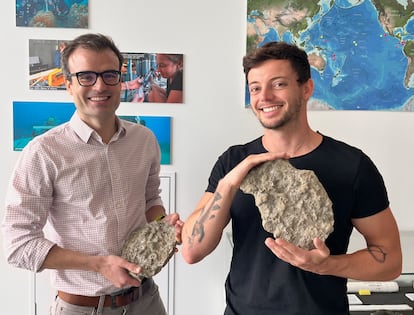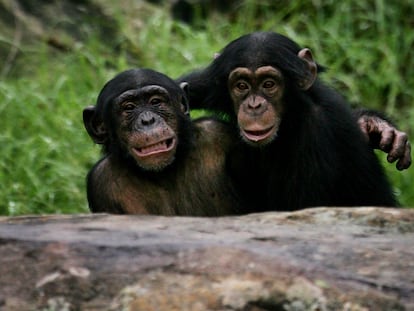One of the first friendships between different species discovered
The symbiosis between corals and algae, observed in fossil reefs 385 million years old, allowed for an explosion of life that feeds 500 million people

Along paths far from the sea, such as those in some towns in the provinces of León and Palencia (Spain), an attentive walker can detect an astonishing presence: archaic coral reefs in the middle of the mountains, among cattle and disused mines. They are the vestiges of another era, the Paleozoic, when tropical seas covered a good part of what is now Europe. A team led by geochemist Alfredo Martínez García has now made an unexpected discovery. The researchers analyzed fossil corals from the interiors of Germany and North Africa and identified the oldest chemical trace of cooperation between strangers, on which much of life on Earth depends: the symbiosis between the only animal visible from space — coral — and single-celled algae. The discovery, a friendship of 385 million years, was published Wednesday in the journal Nature.
In the drama of evolution, symbiosis is the quiet force that redesigns destinies and redefines possibilities, in the words of the American essayist Dorion Sagan. A German botanist, Albert Bernhard Frank, coined the term symbiosis in 1877, to refer to the common life of two totally different species in a single organism: the lichen, an inseparable couple formed by a fungus and an alga. The biologist Leopoldo García Sancho proclaims in a new book, The triumph of a strange friendship, that these small symbioses “move the world.”
García Sancho, a professor at the Faculty of Pharmacy at the Complutense University of Madrid, is not exaggerating. He recalls that in April 1836, a 22-year-old English naturalist named Charles Darwin arrived at the Cocos Atolls in the Indian Ocean aboard the ship HMS Beagle. The young scientist sensed that corals grew toward the light and tried to stay very close to the surface. García Sancho explains why: corals are tiny sedentary animals with tentacles, but they obtain most of their nutrients from unicellular algae that live inside their bodies. It is an intracellular endosymbiosis, “the most intimate form of relationship between strangers,” according to the professor.
The algae that live inside coral, called zooxanthellae, need sunlight to carry out photosynthesis and transform carbon dioxide into sugars, which is why corals only live in crystalline and bright waters. This perfect symbiosis produces “the miracle,” as García Sancho describes it. Reefs cover only 0.2% of the ocean floor, but they are home to a quarter of all marine species and provide food for 500 million people, according to the United Nations.
Martínez García has been leading his own group at the Max Planck Institute for Chemistry in Mainz (Germany) since 2015. He and his American colleague Daniel Sigman developed a revolutionary new technique more than a decade ago, capable of analyzing a few micrograms of matter and determining the concentration of the two stable variants of nitrogen: nitrogen-14 (light) and nitrogen-15 (heavy). “This gives us information about the relationships between different organisms: who eats whom,” says Martínez García.
“When you eat, you metabolise light nitrogen more quickly and you excrete it in your urine, so you are enriched in heavy nitrogen in proportion to your food. This is very interesting, because it is a fairly fixed quantity between different organisms,” the Max Planck researcher continues. Scientists measure this enrichment in parts per thousand. A herbivore would be enriched by about four parts per thousand in relation to the plant it eats, while a carnivore would be enriched by about four parts per thousand in relation to the herbivore it eats, and about eight parts per thousand in relation to the plant, according to Martínez García. “By measuring the concentration of animal tissues, you can reconstruct complicated food webs,” he says.
His team has analyzed fossil corals recently collected in Sauerland, a mountainous area in the German interior, and other historical specimens kept at the Natural History Museum in Frankfurt, from the German volcanic region of Eifel, from Tafilalet (Morocco) and from Western Sahara. They are the remains of reefs from the Devonian, a period of the Paleozoic that began about 419 million years ago and ended about 359 million years ago, when the planet had two supercontinents: Gondwana and Laurasia.
Martínez García’s group has also examined living corals. On the same reef, most have unicellular algae inside them, but others do not and obtain food with their tentacles. The team has observed that corals that eat on their own are enriched in heavy nitrogen by around four thousandths, compared to corals that obtain nutrients from their algae. “If you have symbionts, you are one trophic level below, like a plant. From the nitrogen point of view, it is as if you were doing the photosynthesis yourself,” says the geochemist.
This feature has led to the inference that some fossil corals were already living in symbiosis 385 million years ago, almost twice as long as previously known. This is the first evidence of symbiosis in corals, but other older friendships between different species have been recorded. The fossil of a lichen found in Weng’an, in southern China, is about 600 million years old.
The ancient friendship between corals and algae may explain why reefs reached enormous sizes in the Paleozoic, despite the scarcity of nutrients in the environment. Today, Australia’s Great Barrier Reef is “the largest living structure on Earth and the only one visible from space,” according to the European Space Agency. García Sancho warns that these giants face a threat: bleaching, a phenomenon caused by the abrupt increase in temperatures, which causes corals to expel their colorful algae, acquiring a pale tone.
“It is estimated that if the average temperature of surface water increases by 1.5 degrees, a large part of this symbiosis will disappear without any possibility of recovery. It is possible that some reefs will survive in places where they seem less sensitive to warming, such as the Persian Gulf and the Red Sea, but they will only be the remains of a magnificent world that is fading away and whose disappearance will take with it a large part of the diversity of our oceans,” warns García Sancho in The Triumph of a Strange Friendship.
Sign up for our weekly newsletter to get more English-language news coverage from EL PAÍS USA Edition
Tu suscripción se está usando en otro dispositivo
¿Quieres añadir otro usuario a tu suscripción?
Si continúas leyendo en este dispositivo, no se podrá leer en el otro.
FlechaTu suscripción se está usando en otro dispositivo y solo puedes acceder a EL PAÍS desde un dispositivo a la vez.
Si quieres compartir tu cuenta, cambia tu suscripción a la modalidad Premium, así podrás añadir otro usuario. Cada uno accederá con su propia cuenta de email, lo que os permitirá personalizar vuestra experiencia en EL PAÍS.
¿Tienes una suscripción de empresa? Accede aquí para contratar más cuentas.
En el caso de no saber quién está usando tu cuenta, te recomendamos cambiar tu contraseña aquí.
Si decides continuar compartiendo tu cuenta, este mensaje se mostrará en tu dispositivo y en el de la otra persona que está usando tu cuenta de forma indefinida, afectando a tu experiencia de lectura. Puedes consultar aquí los términos y condiciones de la suscripción digital.











































